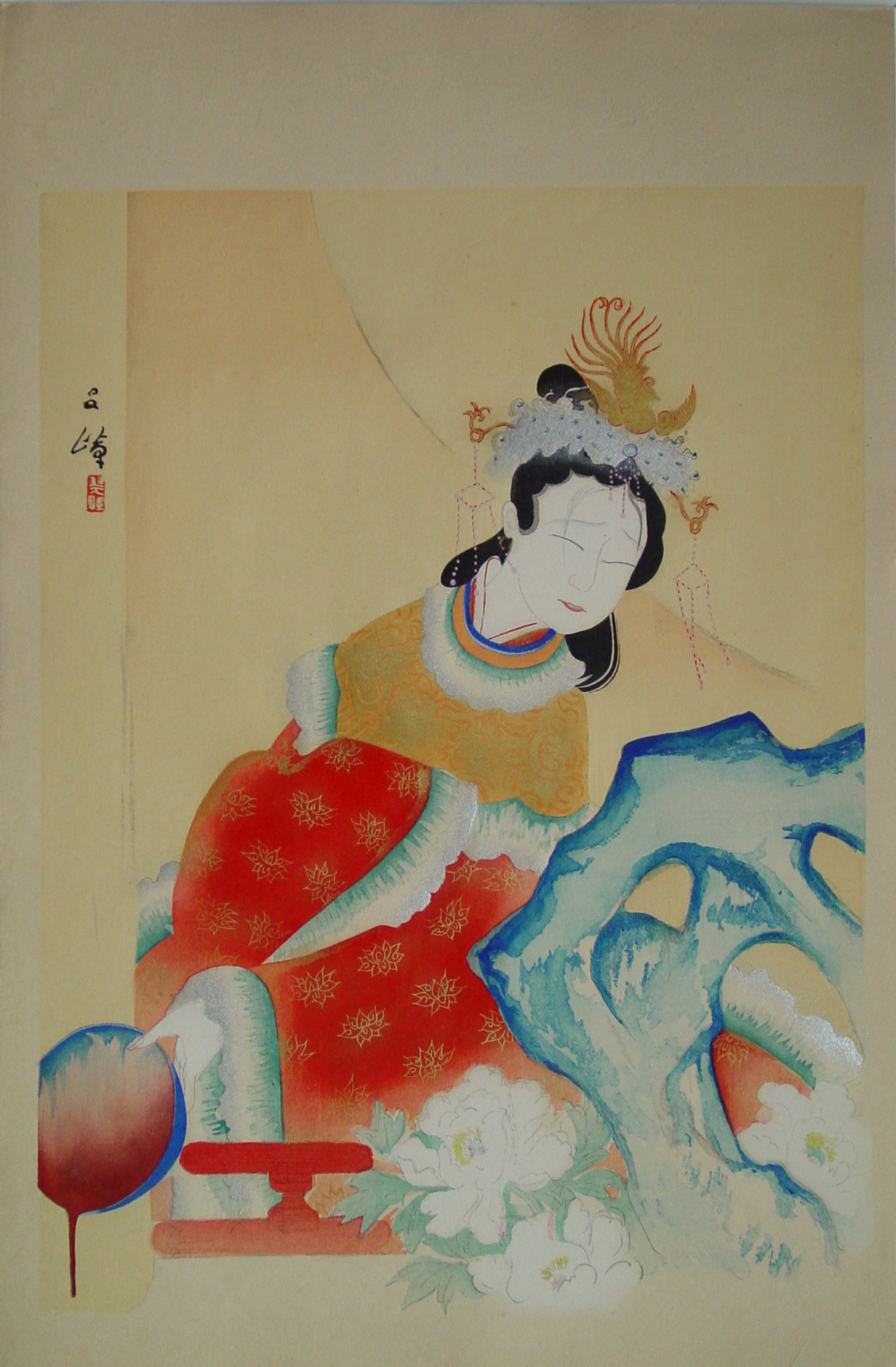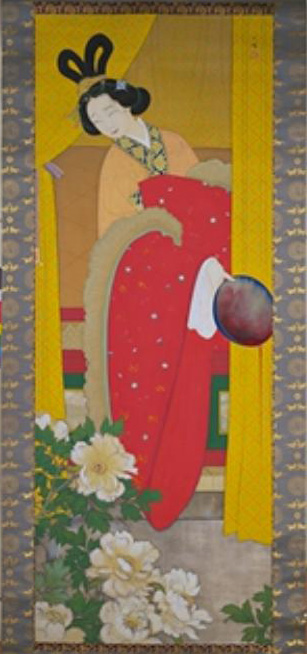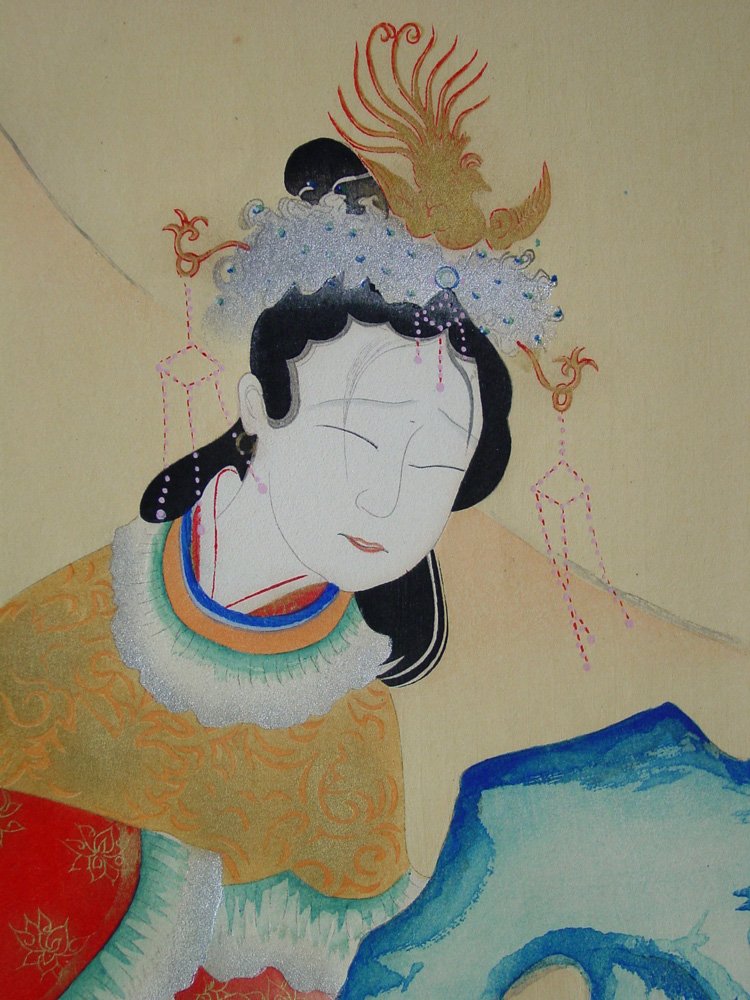About This Print
One of 18 prints published from 1922 to 1923 as part of the celebration of the two-hundredth anniversary of the death of Chikamatsu Manzaemon (1623-1724), perhaps the greatest dramatist in the history of the Japanese theater. Each design illustrates a scene or character from one of Chikamatsu’s famous works. For more details on this series go to Woodblock Print Supplements to the Complete Works of Chikamatsu.Interestingly, in 1921, prior to this print being issued, the artist created the following hanging scroll depicting the same scene.
Kinshōjo, 1921
color on silk・hanging scroll
The National Museum of Modern Art, Kyoto
Source: Website of Osaka Prints http://www.osakaprints.com/content/artists/info_pp/hironobu_info/hironobu_04a.htm (note link is no longer accurate)
Kokusenya kassen (Battles of Kokusenya), written by Chikamatsu Monzaemon (1653-1724), has long been considered a masterpiece of the puppet theater (jōruri or bunraku). First staged in 1715, it remains unsurpassed as the most successful play in the history of jôruri. A kabuki version was first staged in 1716.
The hero Watōnai Sankan, a fisherman by trade, was also the son of Ikkan, a former Ming minister who had been exiled to Japan. Trained in military strategy, Watōnai travels with Ikkan to China to aid a princess named Sendan, younger sister of the Chinese emperor murdered by the Tartars. Their intention is to fulfill his father's promise to restore the Ming dynasty and place Sendan on the throne. Once there, they find Ikkan’s daughter and Watōnai's half-sister, Kinshōjo, married to a general named Kanki, of Ming ancestry but allied with the Tartars. Kinshōjo, loyal to her father and Watōnai, agrees to ask Kanki to join Watōnai, but she has them wait outside the Lion Castle for a sign of her husband's intentions: a powder — white for "yes" and red for "no" — to be tossed into cascading water flowing down to the castle moat. Kanki is sympathetic to her request but cannot take advice from a woman on military matters, as it would bring shame upon himself and his descendants. He is also bound by a promise he has made to the Tartars to kill Watōnai. Always the warrior, Kanki considers murdering his wife to quell any rumors of his being a coward, but is dissuaded by Kinshōjo's stepmother (Watōnai's Japanese mother, who was allowed to enter the castle to plead their cause).
In the most celebrated scene — called beni nagashi shishigajō ("the red signal inside the castle") — Kinshōjo stabs herself and, in place of the red powder, lets her blood flow into the conduit. Her death will free Kanki to fight the Tartars. Upon seeing the "red signal," Watōnai bursts into the Lion Castle to confront Kanki, whereupon the two become allies and Watōnai is given the name Kokusenya, Lord of Enpei.
color on silk・hanging scroll
The National Museum of Modern Art, Kyoto
The Story of Kokusenya Kassen
In 1705, for reasons unknown, Chikamatsu turned his energies exclusively to writing puppet plays. He moved to Osaka, the center of the joruri world, and became staff playwright at the Takemotoza. While Shakespeare probably never considered writing for puppets, it is notable that, like the bard, Chikamatsu did often write historical plays. Kokusenya Kassen (The Battles of Co Xin Ga), for example, is loosely based on the adventures of a Chinese-Japanese who attempted to restore China's Ming Dynasty.Source: Website of Osaka Prints http://www.osakaprints.com/content/artists/info_pp/hironobu_info/hironobu_04a.htm (note link is no longer accurate)
Kokusenya kassen (Battles of Kokusenya), written by Chikamatsu Monzaemon (1653-1724), has long been considered a masterpiece of the puppet theater (jōruri or bunraku). First staged in 1715, it remains unsurpassed as the most successful play in the history of jôruri. A kabuki version was first staged in 1716.
The hero Watōnai Sankan, a fisherman by trade, was also the son of Ikkan, a former Ming minister who had been exiled to Japan. Trained in military strategy, Watōnai travels with Ikkan to China to aid a princess named Sendan, younger sister of the Chinese emperor murdered by the Tartars. Their intention is to fulfill his father's promise to restore the Ming dynasty and place Sendan on the throne. Once there, they find Ikkan’s daughter and Watōnai's half-sister, Kinshōjo, married to a general named Kanki, of Ming ancestry but allied with the Tartars. Kinshōjo, loyal to her father and Watōnai, agrees to ask Kanki to join Watōnai, but she has them wait outside the Lion Castle for a sign of her husband's intentions: a powder — white for "yes" and red for "no" — to be tossed into cascading water flowing down to the castle moat. Kanki is sympathetic to her request but cannot take advice from a woman on military matters, as it would bring shame upon himself and his descendants. He is also bound by a promise he has made to the Tartars to kill Watōnai. Always the warrior, Kanki considers murdering his wife to quell any rumors of his being a coward, but is dissuaded by Kinshōjo's stepmother (Watōnai's Japanese mother, who was allowed to enter the castle to plead their cause).
In the most celebrated scene — called beni nagashi shishigajō ("the red signal inside the castle") — Kinshōjo stabs herself and, in place of the red powder, lets her blood flow into the conduit. Her death will free Kanki to fight the Tartars. Upon seeing the "red signal," Watōnai bursts into the Lion Castle to confront Kanki, whereupon the two become allies and Watōnai is given the name Kokusenya, Lord of Enpei.
Print Details
| IHL Catalog | #147 |
| Title or Description | Princess Kinshōjo in the play Kokusenya Kassen (note: the MFA, Boston lists the title of this work as The Sister of Watōnai Committing Suicide, a specific scene in the play, as described above.) |
| Series | Woodblock Print Supplements to the Complete Works of Chikamatsu Dai Chikamatsu zenshu furoku mokuhan 大近松全集 付録木版 |
| Artist | Nishiyama Suishō (1879-1958) |
| Signature |  |
| Seal | unread artist's seal (see above) |
| Publication Date | between 1922-1923 |
| Edition | likely first edition, but the number of editions issued is unknown |
| Publisher | Dai Chikamatsu zenshū kankōkai 大近松全集刊行会 (the Complete Work of Chikamatsu Publishing Association) |
| Carver | Yamagishi Kazue 1893-1996 |
| Printer | Nishimura Kumakichi |
| Impression | excellent |
| Colors | excellent |
| Condition | excellent - some apparent oxidation of pigment on hands and face |
| Miscellaneous | all prints from this series printed on a light tan-colored paper |
| Genre | shin hanga (new prints) |
| Format | dai-oban |
| H x W Paper | 18 x 11 1/4 in. (45.7 x 28.6 cm) |
| H x W Image | 17 x 10 5/8 in. (43.2 x 27 cm) measurement includes gray border |
| Collections This Print | Museum of Fine Arts, Boston 51.1754; The Tsubouchi Memorial Theatre Museum of Waseda University 201-0377 and 201-0378 |
| Reference Literature | |




